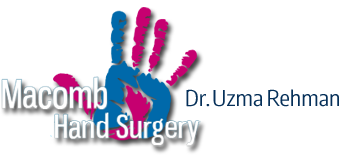Surgeons Explain Total Elbow Replacement Surgery
Joint replacement is more common in the knee or hip, but it is equally as successful in the elbow to relieve joint pain, restore mobility and enable patients to return to the activities they enjoy.
In this article, Oakland County board-certified hand surgeon Dr. Uzma Rehman will help you understand elbow replacement surgery.
Anatomy of the Elbow
The elbow is basically a “hinged” joint that is made up of three bones coming together: the humerus (upper arm bone), ulna (forearm bone on pinky side), and radius (forearm bone on thumb side).
The ends of the bones where they meet and form the elbow joint are covered with cartilage, a slick substance that protects the bones and enables them to move easily without rubbing against each other. Additionally, a thin tissue called synovial membrane covers the surfaces inside the elbow joint, that produces a small amount of fluid that lubricates the cartilage and eliminates almost friction when the arm is bent or rotated.
And, of course, muscles, ligaments, and tendons hold the bones in the elbow together – as they do in every joint.
Who Needs Elbow Replacement Surgery?
There are several conditions that can cause elbow pain and disability, lead a hand surgeon to consider elbow joint replacement surgery as a patient’s best option. These conditions include:
Rheumatoid Arthritis: chronic inflammation that damages the cartilage, eventually causing cartilage loss, extreme pain, and stiffness.
Osteoarthritis: age-related, “wear and tear” causes the cartilage to wear away leaving bon-on-bone. Osteoarthritis usually occurs in people 50 years of age and older but may occur in younger people.
Post-traumatic Arthritis: Fractures of the bones in the elbow, or tears of the surrounding tendons and ligaments may cause damage to the cartilage over time, resulting in pain and limited elbow function.
Severe Fractures: If the elbow is shattered, a surgeon may not be able to put the pieces of bone back in place and/or the blood supply to the bone pieces can be compromised. Older patients with osteoporosis are most at risk for severe elbow fractures requiring total elbow replacement surgery.
Instability: when the ligaments that hold the elbow joint together are seriously damaged the elbow is prone to dislocation. Chronic instability requiring total elbow replacement surgery is most often caused by an injury, such as a severe fall, car or motorcycle accident, or other trauma to the elbow.
Total Elbow Replacement Surgery
During total elbow replacement surgery, the damaged parts of the humerus (upper arm bone) and ulna (smaller lower arm bone on the pinky side) are replaced with artificial components. The artificial elbow joint consists of a metal hinge with ‘stems’ that fit inside the hollow part of the bone called the canal. A plastic ‘spacer’ between the two metal sides cushions the metal and “rocks” enabling the ‘hinge’ to open and close.
There are different types of artificial elbow replacement implants, as well as partial elbow replacements. Oakland County board-certified hand surgeon Dr. Rehman will discuss your options with you, to help you determine what type of elbow replacement is best for you.
Recovery After Total Elbow Replacement Surgery
Patients typically stay at the hospital 2 to 4 days after total elbow replacement surgery. They will be given antibiotics to prevent infection, and medications can be prescribed for short-term pain relief after surgery.
Generally, patients are not allowed to put any weight on the arm or push against resistance with the hand until about 6 weeks after your surgery. Rehabilitation with our skilled and certified physical therapists is critical to the success of any elbow replacement surgery. Patients will learn exercises for the hand and wrist to avoid stiffness, control swelling, reduce pain and improve range-of-motion exercises as the incision heals.
Elbow Replacement Surgery | Oakland County Surgeon
If you are suffering from pain, swelling, stiffness, arthritis, or other elbow problems, contact board-certified Oakland County surgeon Doctor Rehman for a comprehensive evaluation and consultation. She will discuss your treatment options with you – with skill, compassion and years of experience – and recommend the best treatment to help you relieve your pain and resume the activities that you enjoy.

